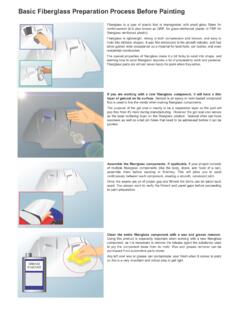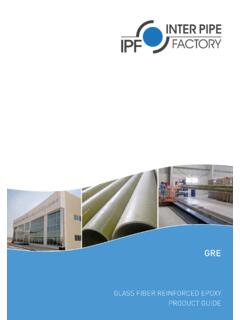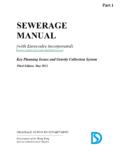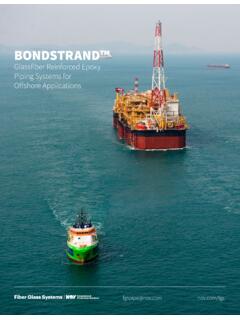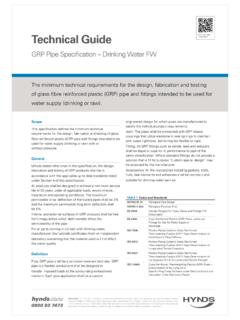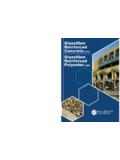Transcription of Wind Turbine - Materials and Manufacturing Fact Sheet
1 wind Turbine Materials and Manufacturing fact Sheet August 29, 2001. wind Turbine - Materials and Manufacturing fact Sheet Prepared for the Office of Industrial Technologies, US Department of Energy By Princeton Energy Resources International, LLC. Dan Ancona and Jim McVeigh Recognition of the value of wind energy as a low cost, clean source for electricity is creating major new business opportunities for Manufacturing and Materials innovation. Worldwide growth in wind generation since 1994 has been 30% or higher annually. The cost of energy from large wind power plants has declined to less than $ at good wind sites. By the end of 2000, the global capacity had passed 17,600 megawatts (MW) [See reference 1], and in the United States alone, more than 1,800 MW of new installations should be completed this year [2, 3]. The combined sales of large wind power plants and small turbines for distributed generation is now $4-5 billion annually worldwide and growing.
2 Small turbines (less than 100 kW each) are being produced for the growing distributed generation and off-grid markets. Grid-connected wind power plants typically employ hundreds of 1 to 2 MW turbines today and larger, 3 to 5. MW machines, with 100-meter (m) (110 yards - longer than a football field) or greater rotors are being developed. The wind Turbine Manufacturing business has grown from a cottage industry, with hand-built subsystems, to sales warranting large-scale production operations. Parts of a wind Turbine wind turbines come in many sizes and configurations and are built from wide range of Materials . In simple terms, a wind Turbine consists of a rotor that has wing shaped blades attached to a hub; a nacelle that houses a drivetrain consisting of a gearbox, connecting shafts, support bearings, the generator, plus other machinery; a tower; and ground-mounted electrical equipment.
3 The wing shaped blades on the rotor actually harvest the energy in the wind stream. The rotor converts the kinetic energy in the wind to rotational energy transmitted through the drivetrain to the generator. Generated electricity can be connected directly to the load or feed to the utility grid [4]. The weight and cost of the Turbine is wind Turbine Nomenclature the key to making wind energy Princeton Energy Resources International, LLC 1. wind Turbine Materials and Manufacturing fact Sheet August 29, 2001. competitive with other power sources, because research programs have significantly improved the efficiency of the rotor and maximized the energy capture of the machine. The real opportunity today is through better, low cost Materials and though high volume production, while ensuring the reliability is maintained. The typical weight and cost of the primary Turbine components today are shown in Table 1.
4 In addition there are foundations and conventional ground-mounted systems, including transformers, switching and other power equipment. There appear to be several areas where Table 1. Turbine Component Weight and Cost technological progress and cost reduction are needed. Turbine Component % of % of subsystem costs are generally evenly Machine Machine split between rotor, nacelle, drivetrain Weight Cost [5]. power systems, and the tower. There is Rotor 10-14 20-30. no single component that dominates Turbine cost. The rotor is the highest Nacelle and machinery, less 25-40 25. cost item on most machines and must Gearbox and 5-15 10-15. be the most reliable. Towers are drivetrain normally the heaviest component and Generator systems 2-6 5-15. could benefit from weight reduction, but lightening the rotor or tower-top Weight on Top of Tower 35-50 N/A.
5 Weight has a multiplier effect Tower 30-65 10-25. throughout the system including the foundation. Expected Technology Evolution The components of turbines are changing as the technology improves and evolves. There is a trend toward lighter weight systems. Light weight, low cost Materials are especially important in blades and towers for several reasons. First the weight of the blades and rotor is multiplied through out the machine. The tower weight is key because it is typically 60%. of the weight of the Turbine above the foundation, due to the fact that sophisticated light- weight, high-strength Materials are often too costly to justify their use. wind Turbine Technology Evolution Princeton Energy Resources International, LLC 2. wind Turbine Materials and Manufacturing fact Sheet August 29, 2001. Another technology shift is occurring in the drive train.
6 In some cases the gearbox is being eliminated by employing variable speed generators and solid state electronic converters that produce utility quality alternating current (AC) power. This trend began in small machines and is now being incorporated in Turbine sizes from 100 kW to 3 MW. Other trends in wind Turbine technology are discussed in detail in the Renewable Energy Technology Characterizations published by the Electric Power Research Institute (EPRI) [5] with DOE support. Market and Turbine Component Materials Data To estimate the quantities and types Table 2. Turbine Models Used in Current and Future of Materials used in wind turbines, a Materials Usage Estimates database was compiled from a variety of industrial, DOE laboratory Turbine Make Rated Power (kW). and existing PERI sources. Much of Southwest Windpower , the wind Turbine and component Bergey , 10.
7 Characteristics and weight data came Atlantic Orient Corp. 50. from the DOE, wind Partnerships for Northern Power Systems 100. Advanced Technologies Enercon 500, 850. (WindPACT) program database Micon 600, 900. Bonus 600, 1000. through NREL and their Vestas 660, 850, 1650, 2000. subcontractors, as well as directly Nordex 1000. from Turbine manufacturers, their Mitsubishi 600, 1000. web sites and marketing Materials . Enron 750, 1500. Twenty-eight types and models of NREL (Concept) 2500, 3500, 5000. turbines were analyzed in this report, ranging from small models for direct current (DC) battery charging ( the kW Southwest Windpower Turbine ), to large grid connected alternating current (AC) machines currently commercially available ( the Enron MW) and being employed in 100-200 MW wind power plants. Very large multi-megawatt machines being designed for future wind farm applications, both on- and off-shore ( the 5 MW NREL concept Turbine ), were also included in expected future markets after 2005.
8 The specific models, type and size, that were assumed for each manufacturer as the basis for estimating current and future market share in our model is shown in Table 2. The actual unit production and sales data incorporated in the market share database is considered proprietary by the manufacturers. This data was used in estimating weights of Materials shown in Table 3. Future Market Projections The surge in growth in wind Turbine installations in the United States and around the world is expected to continue and actually accelerate. In a study conducted by the World Energy Council (WEC) projected worldwide wind capacity of 13 gigawatts (GW) by 2000 (actual installed capacity was GW by the end of 1999), increasing to 72 GW by 2010 and 180 GW by 2020. WEC also considered an environmentally driven scenario that has much faster growth if national policies were adjusted.
9 That scenario projected 470 GW of wind power by 2020. Princeton Energy Resources International, LLC 3. wind Turbine Materials and Manufacturing fact Sheet August 29, 2001. In the United States, the American wind Energy Association (AWEA) supports the DOE. projections for wind power. Provide at least 5% of the nation's electricity by 2020 with 10 GW online by 2010 and 80. GW by 2020. Double the number of states with more than 20 MW installed to 16 by 2005 and to 24 by 2010. Provide 5% of the electricity used by the federal government (the largest single consumer of electricity) by 2010 with 1,000 MW online. The members of the European wind Energy Association (EWEA) have increased their estimates for wind installations in that region. Since 1993, the market for new turbines has grown at over 40 % per year. During 1999 was a record year with over 3000 MW installed in that year, resulting in a total installed capacity of 9,500 MW.
10 This is well above the EWEA's old target for 2000 of 8000 MW. With support from the European Commission, studies show and the wind industry believes that the target of 40 GW will also be passed sooner, so the target for 2010 has been raised to 50 GW, of which 5 GW are expected to be offshore capacity. Similarly, a new target of 150 GW was agreed to by EWEA for 2020, of which 50 GW will be offshore. The future markets for wind turbines in the United States and Europe are large but the biggest potential is expected to be in Asia, Latin America, the Former Soviet Union and Africa. These are the markets where demand for electricity is growing the fastest and the need for sustainable development with reliance on domestic energy resources are the greatest [6]. Growth in these markets could surpass both Europe and the by 2020. Materials Usage in Current wind Turbines A wide range of Materials are used in wind turbines.
